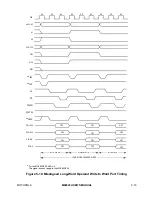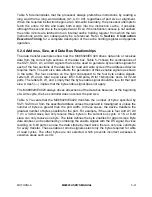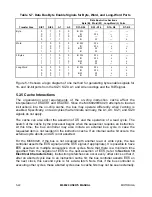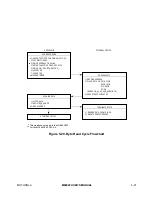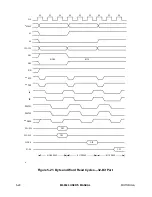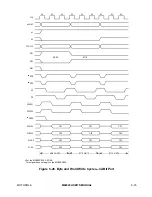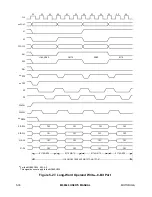
5- 24
M68020 USER’S MANUAL
MOTOROLA
5.2.6 Bus Operation
The MC68020/EC020 bus is used in an asynchronous manner allowing external devices
to operate at clock frequencies different from the MC68020/EC020 clock. Bus operation
uses the handshake lines (
AS
,
DS
,
DSACK0
,
DSACK1
,
BERR
, and
HALT
) to control data
transfers.
AS
signals the start of a bus cycle, and
DS
is used as a condition for valid data
on a write cycle. Decoding SIZ1, SIZ0, A1, and A0 provides byte enable signals that select
the active portion of the data bus. The slave device (memory or peripheral) then responds
by placing the requested data on the correct portion of the data bus for a read cycle or
latching the data on a write cycle and by asserting the
DSACK0
/
DSACK1
combination that
corresponds to the port size to terminate the cycle. If no slave responds or the access is
invalid, external control logic asserts
BERR
to abort or
BERR
and
HALT
to retry the bus
cycle.
DSACK1
/
DSACK0
can be asserted before the data from a slave device is valid on a read
cycle. The length of time that
DSACK1
/
DSACK0
may precede data is given by parameter
#31, and it must be met in any asynchronous system to ensure that valid data is latched
into the processor. (Refer to Section 10 Electrical Characteristics for timing
parameters.) Note that no maximum time is specified from the assertion of
AS
to the
assertion of
DSACK1
/
DSACK0
. Although the processor can transfer data in a minimum of
three clock cycles when the cycle is terminated with
DSACK1
/
DSACK0
, the processor
inserts wait cycles in clock period increments until
DSACK1
/
DSACK0
is recognized.
The
BERR
and/or
HALT
signals can be asserted after
DSACK1
/
DSACK0
is asserted.
BERR
and/or
HALT
must be asserted within the time given (parameter #48), after
DSACK1
/
DSACK0
is asserted in any asynchronous system. If this maximum delay time is
violated, the processor may exhibit erratic behavior.
5.2.7 Synchronous Operation with
DSACK1
/
DSACK0
Although cycles terminated with
DSACK1
/
DSACK0
are classified as asynchronous, cycles
terminated with
DSACK1
/
DSACK0
can also operate synchronously in that signals are
interpreted relative to clock edges. The devices that use these synchronous cycles must
synchronize the responses to the MC68020/EC020 clock. Since these devices terminate
bus cycles with
D S A C K 1
/
D S A C K 0
, the dynamic bus sizing capabilities of the
MC68020/EC020 are available. In addition, the minimum cycle time for these synchronous
cycles is three clocks.
To support systems that use the system clock to generate
DSACK1
/
DSACK0
and other
asynchronous inputs, the asynchronous input setup time (parameter #47A) and the
asynchronous input hold time (parameter #47B) are provided in Section 10 Electrical
Characteristics. (Note: although a misnomer, these “asynchronous” parameters are the
setup and hold times for synchronous operation.) If the setup and hold times are met for
the assertion or negation of a signal, such as
DSACK1
/
DSACK0
, the processor can be
guaranteed to recognize that signal level on that specific falling edge of the system clock.
If the assertion of
DSACK1
/
DSACK0
is recognized on a particular falling edge of the clock,
valid data is latched into the processor (for a read cycle) on the next falling clock edge
provided the data meets the data setup time (parameter #27). In this case, parameter #31
Summary of Contents for MC68020
Page 16: ...9 29 95 SECTION 1 OVERVIEW UM Rev 1 0 xx M68020 USER S MANUAL MOTOROLA ...
Page 268: ...MOTOROLA M68020 USER S MANUAL 9 13 Figure 9 9 Access Time Computation Diagram ...
Page 286: ...MOTOROLA M68020 USER S MANUAL 10 11 Figure 10 3 Read Cycle Timing Diagram ...
Page 287: ...10 12 M68020 USER S MANUAL MOTOROLA Figure 10 4 Write Cycle Timing Diagram ...
Page 288: ...MOTOROLA M68020 USER S MANUAL 10 13 Figure 10 5 Bus Arbitration Timing Diagram ...






